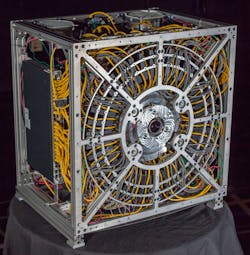If you have been to a security tradeshow lately, you may have been wowed by Arecont Vision's 20 Megapixel Camera or blown away by the images on Avigilon's 29 MP camera. Well, researchers at Duke University have a message: You ain't seen nothing yet!
Researchers have unveiled a supercamera that can take gigapixel pictures — that's 1,000 megapixels — and they say the cameras could have military, commercial and civilian applications, and that handheld gigapixel cameras may one day be possible.
According to a report from Innovation News Daily, the gigapixel camera uses 98 identical microcameras in unison, each armed with its own set of optics and a 14-megapixel sensor. The microcameras, in turn, all peer through a single large spherical lens to collectively see a scene. A specially designed electronic processing unit stitches together all the partial images each microcamera takes into a giant, one-gigapixel image.
Of course, the camera looks like it's slightly bigger than a breadbox, so practical applications are probably in the distant future. The device measures 29.5 by 29.5 by 19.6 inches (75 by 75 by 50 centimeters) — a size required to cool its electronics and keep them from overheating. However, a look at the images produced reveals a scene vaguely similar to those 20-plus megapixel demos on the security trade show floors.
"In the near-term, gigapixel cameras will be used for wide-area security, large-scale event capture — for example, sport events and concerts — and wide-area multiple-user scene surveillance — for example, wildlife refuges, natural wonders, tourist attractions," Duke researcher David Brady told Innovation News Daily. "As an example, a gigapixel camera mounted over the Grand Canyon or Times Square will enable arbitrarily large numbers of users to simultaneously log on and explore the scene via telepresence with much greater resolution than they could if they were physically present."
The gigapixel device currently delivers one-gigapixel images at a speed of about three frames per minute. It actually captures images in less than a tenth of a second — it just takes 18 seconds to transfer the full image from the microcamera array to the camera's memory. The images are only in black-and-white for now, but future generations of the camera would be in color, the researcher said.
The researchers are also working on more powerful cameras. They have currently built a two-gigapixel prototype camera that possesses 226 microcameras, and are in the manufacturing phase for a 10-gigapixel system. Ten- to 100-gigapixel cameras "will remain more backpack-size rather than handheld," Brady said.




